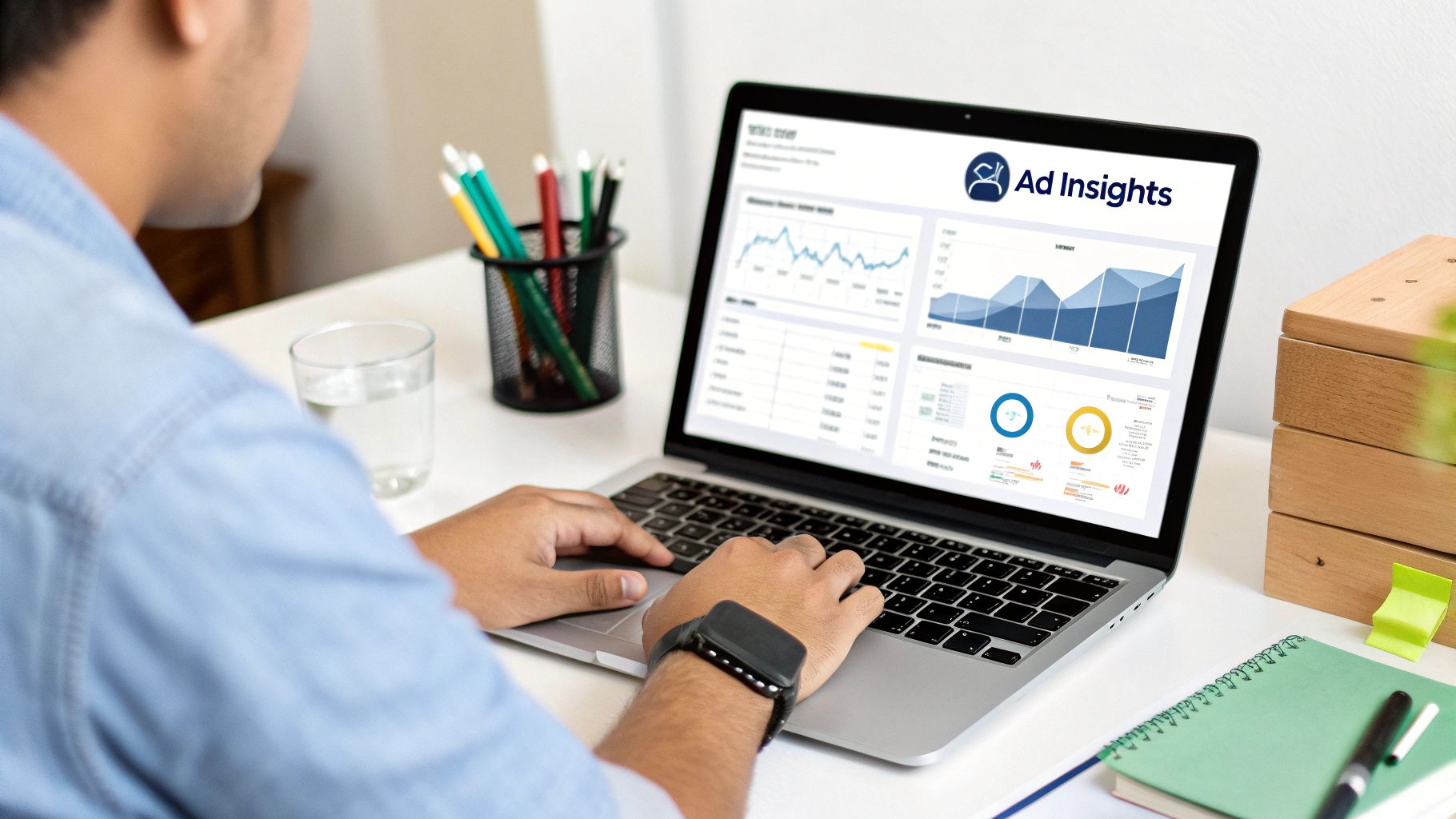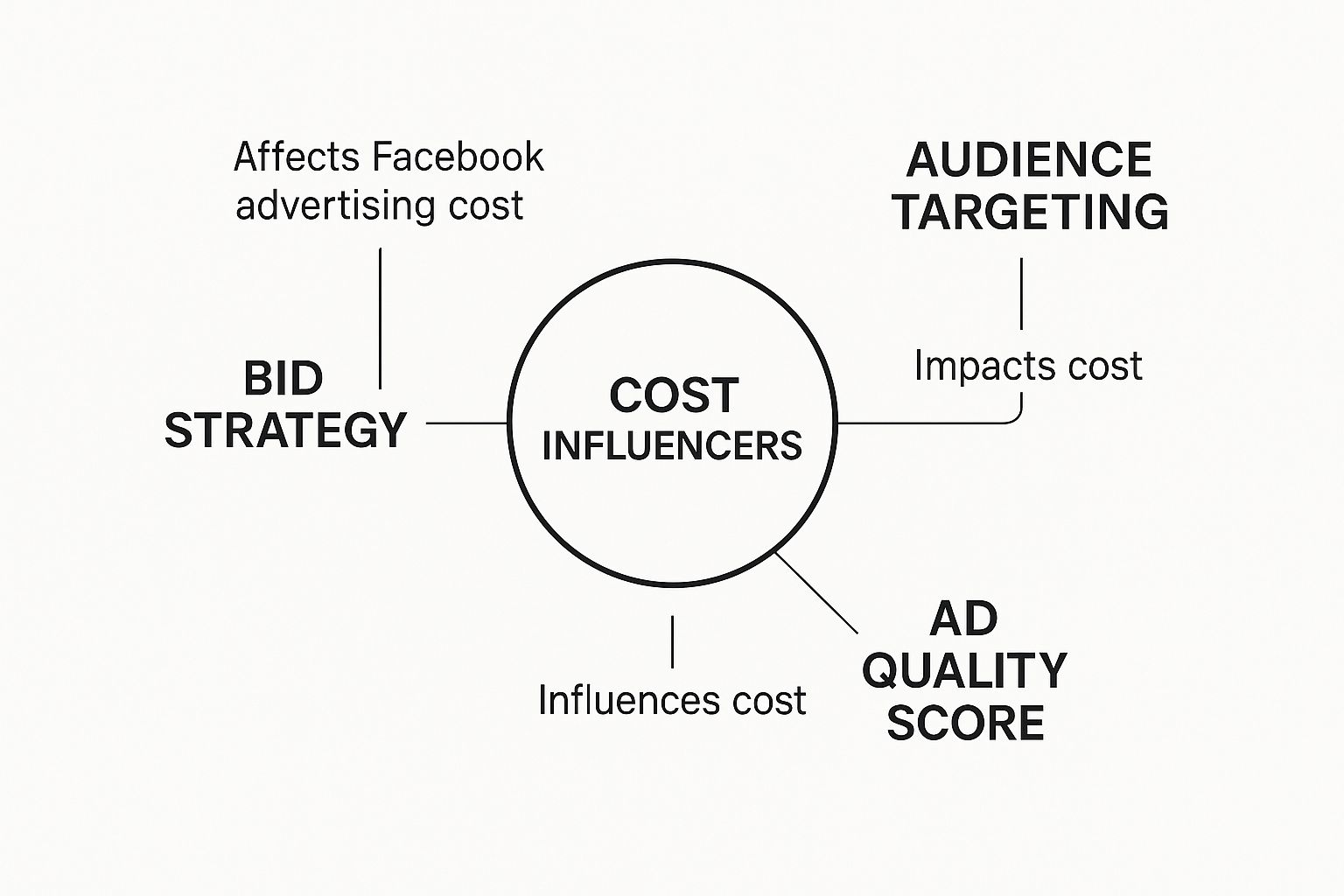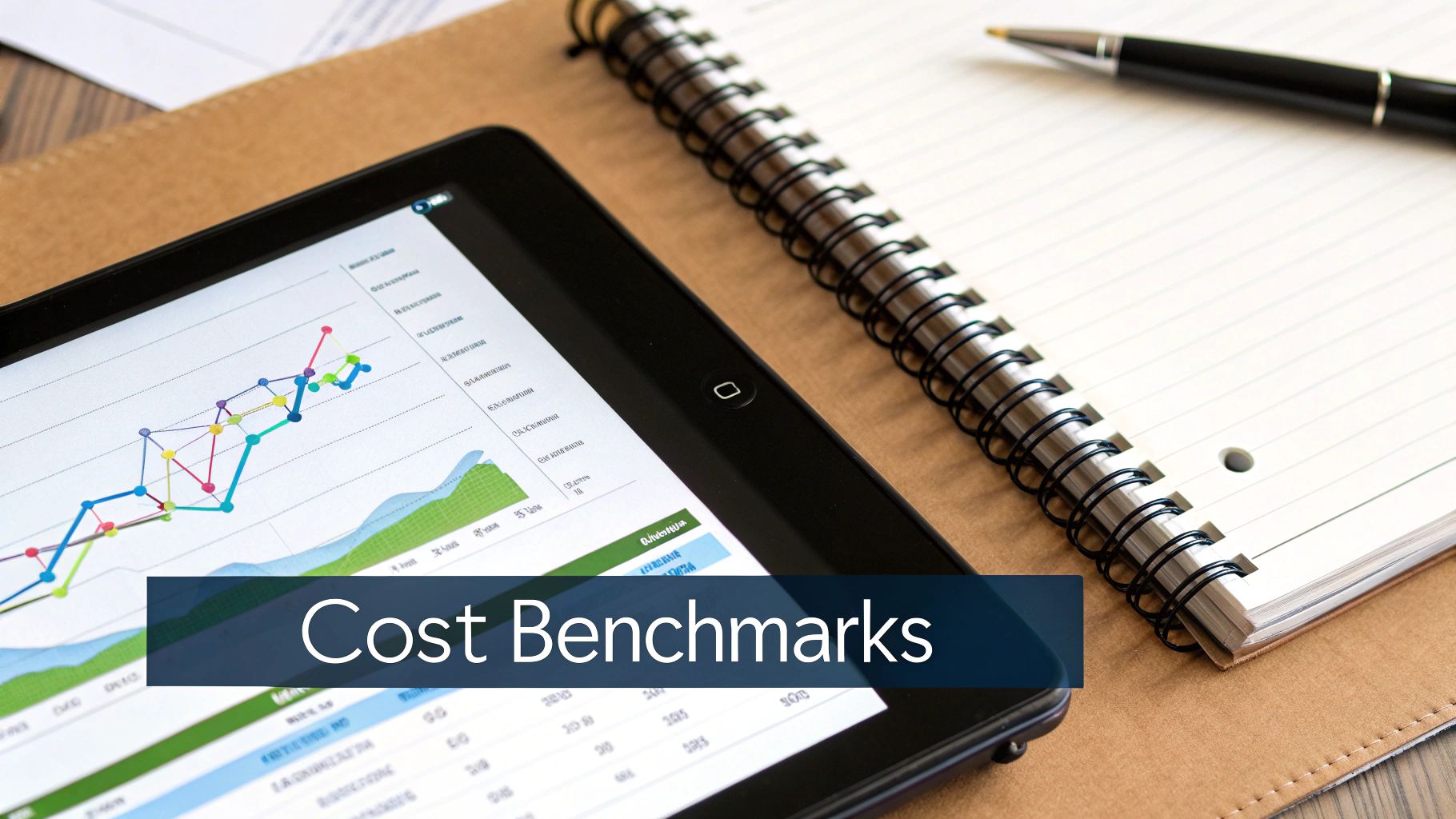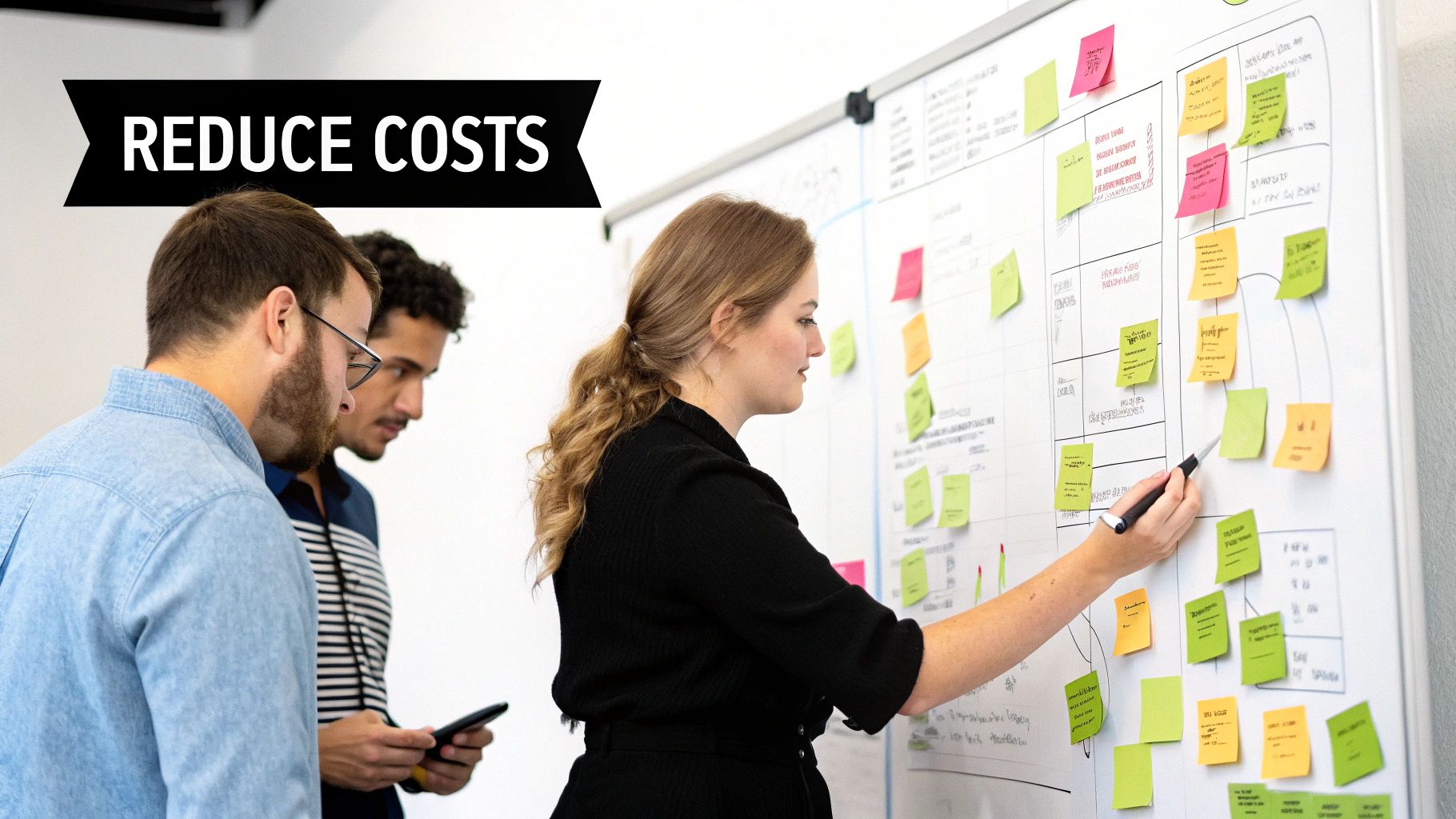Decoding Facebook Advertising Cost in the UK

Facebook Advertising Cost: Trying to pin down the exact Facebook advertising cost can feel a bit like trying to nail jelly to a wall. The good news? It’s much more straightforward than it seems.
As a rule of thumb, businesses here in the UK can generally expect to pay somewhere between £0.50 and £1.50 per click (CPC). If you’re more focused on getting eyeballs on your brand, you’ll be looking at around £5 to £9 per 1,000 impressions (CPM). But these are just starting points; the final figure is a dynamic number that you have a surprising amount of control over.
Facebook Advertising Cost: Your Quick Guide to Facebook Ad Costs

The first thing to get your head around is that there’s no fixed price list for Facebook ads. It’s not like buying a coffee. A better way to think of it is as a massive, real-time auction. You’re bidding for a prime spot in front of your ideal customer in a bustling digital marketplace.
Your budget, the quality of your ad, and how well you’ve targeted your audience all play a huge part in determining your final costs. This auction system is why two businesses can spend wildly different amounts and still achieve similar results. A financial services company, for example, will likely pay a lot more per click than a local boutique, simply because there’s a stampede of other advertisers fighting for the same audience.
A Starting Point for Your Budget
To help you get started, here’s a quick look at some average benchmarks for Facebook ad costs in the UK.
This table provides a quick overview of typical cost ranges for the most common Facebook advertising metrics, helping you estimate potential campaign expenses.
| Metric | Average Cost Range (UK) | Best For |
|---|---|---|
| Cost Per Click (CPC) | £0.50 – £1.50 | Driving traffic to a website or landing page. |
| Cost Per 1,000 Impressions (CPM) | £5 – £9 | Building brand awareness and reaching a broad audience. |
| Cost Per Lead (CPL) | £5 – £30+ | Generating leads, with B2B often at the higher end. |
| Cost Per App Install (CPI) | £1.50 – £4 | Encouraging users to download your mobile app. |
| Cost Per Engagement (CPE) | £0.05 – £0.25 | Boosting likes, comments, shares, and post interactions. |
These figures give you a solid foundation for planning. Knowing these numbers helps you set a realistic budget that allows for proper testing and refinement without breaking the bank.
Your budget isn’t just an expense; it’s an investment in data. A modest initial spend allows Facebook’s algorithm to learn who responds best to your message, paving the way for more efficient, scalable campaigns later on.
This initial learning phase is absolutely crucial. By seeing who bites, you can start optimising your strategy. Getting a feel for what works is key, and it never hurts to check out some of the most effective https://ppcgeeks.co.uk/ppc/facebook-ads-examples/ out there for a bit of creative inspiration.
Ultimately, this knowledge empowers you to make smarter decisions, ensuring every pound you spend is working hard to hit your business goals.
How the Facebook Ad Auction Really Works
Facebook Advertising Cost: Lots of people think the highest bidder always snags the ad spot on Facebook. That’s not quite right. It’s better to think of it as a ‘relevance competition’, where the quality of your ad can pack a bigger punch than the size of your budget.
When you kick off a campaign, you aren’t just buying ad space. You’re diving into a lightning-fast auction for every single impression. For each ad spot that opens up, Facebook’s algorithm instantly weighs up every potential ad and picks the one it thinks will deliver the most value—both for the user and for the advertiser.
This is brilliant news. It means a smaller business with a really engaging ad can genuinely outplay a massive competitor with deep pockets. Grasping this simple idea is the first step to lowering your Facebook advertising cost. It’s about advertising smarter, not just spending more.
The Three Pillars of the Ad Auction
Facebook’s decision-making process really boils down to three core ingredients. The algorithm mashes these together to create a single ‘total value’ score. The ad with the highest score wins the placement. Simple as that.
These are the key factors that dictate your costs, as you can see in the diagram below.

This shows how your bid, your audience targeting, and your ad quality are all tangled up together, directly shaping what you end up spending.
Let’s break down what each of these pillars actually means for your campaign:
- Your Bid: This is the most straightforward part. It’s the cash you’re prepared to pay to get the result you want. Whether you set this figure yourself or let Facebook’s algorithm handle it, this is your direct financial stake in the auction.
- Estimated Action Rates: This is Facebook’s best guess at how likely someone is to actually take the action you’re after (like clicking a link, making a purchase, or watching your video). The algorithm looks at your past campaign performance and the user’s own history to make this educated prediction.
- Ad Quality: This score is all about how good and relevant your ad is. It takes into account feedback from people who have seen or hidden your ad, and it also sniffs out low-quality stuff like clickbait or over-the-top language.
Think of it like this: your bid is just the entry fee to get into the competition. But it’s the estimated action rates and your ad quality score that really decide how well you do. A high-quality, relevant ad essentially gets a “bonus” in the auction, making every penny of your bid stretch further.
At the end of the day, Facebook wants to show its users stuff they’ll actually find interesting. By rewarding advertisers who create a positive experience, the platform keeps people scrolling and coming back for more. This focus on relevance is your single biggest advantage for managing and cutting down your Facebook advertising cost.
The 5 Key Factors That Drive Your Ad Spend

So, you understand the basics of the Facebook ad auction. But what actually decides the final price you end up paying? Your Facebook advertising cost isn’t just a random number; it’s the outcome of several moving parts all working together.
Think of these factors as levers you can pull. When you get a handle on how each one works, you can start to diagnose why your costs are what they are. More importantly, you can take control and make every pound you spend work harder.
There are five key elements that are always in play, shaping everything from your cost per click to your final return on investment. Mastering them is what separates simply spending money from strategically investing it.
1. Your Audience Targeting
Who you’re trying to reach is one of the biggest drivers of your ad costs. It’s a simple case of supply and demand. If you’re targeting a massive audience, like “women in the UK aged 25-40,” you’re fishing in a huge pond. There are millions of users, so the competition for each impression is relatively low, keeping costs down.
But let’s say you dial it in. Now you’re targeting “women in Manchester aged 30-35 who are interested in luxury skincare and have an upcoming anniversary.” You’re now aiming for a much smaller, higher-value group. Other advertisers are tripping over themselves to reach these exact same people, which naturally drives the bidding price sky-high.
The more desirable and specific your audience, the more you should expect to pay to get in front of them. Nailing this balance is crucial, and you can learn more about how to target audiences on Facebook to sharpen your approach.
2. Your Ad Quality and Relevance
At the end of the day, Facebook wants to keep its users happy and engaged. That’s their business model. To do this, they actively reward advertisers who create high-quality, relevant ads that people genuinely want to see—and they penalise those who don’t.
The platform measures this with metrics like your Quality Ranking and Engagement Rate Ranking. An ad that gets high click-through rates, tons of likes, comments, and shares is a clear signal to Facebook that users find it valuable.
As a reward, Facebook will show your top-notch ad to more people for less money. On the flip side, if your ad is constantly getting ignored or hidden, Facebook will effectively hit you with a “nuisance tax,” charging you more to show it.
3. Your Campaign Objective
The goal you set at the very beginning of your campaign has a massive impact on your costs because Facebook optimises delivery based on what you ask it to do.
- Awareness or Reach Campaigns: These are generally the cheapest. Facebook’s job is simply to get your ad in front of as many eyeballs as possible within your budget. Easy enough.
- Traffic or Engagement Campaigns: These sit in the middle of the price range. Here, Facebook targets users who are known clickers, likers, and sharers.
- Conversion or Lead Campaigns: These are often the most expensive. Facebook is now hunting for a very specific type of person: someone who is highly likely to take a valuable action, like making a purchase or filling out a form. These users are gold dust, and therefore cost more to reach.
While a conversion campaign might have a higher cost per impression (CPM), its cost per acquisition (CPA) should be lower because it’s laser-focused on the action that actually makes you money.
4. The Industry and Competition
The sector you operate in plays a huge role in what you’ll pay. Some industries are just flat-out more competitive—and therefore more expensive—than others.
For example, the finance and insurance industries often see some of the highest CPCs, sometimes shooting past £3.00 per click. In stark contrast, less cut-throat sectors like apparel or retail can enjoy CPCs as low as £0.45. Why the big difference? The potential lifetime value of a new customer in finance is enormous, justifying a much higher upfront ad spend.
5. Seasonality and Timing
Finally, don’t forget the calendar. The time of year can cause dramatic swings in your ad costs. The ad auction is a marketplace, and when demand spikes during peak shopping periods, so do the prices.
The most famous example is Q4 (October-December), home to Black Friday and the Christmas shopping frenzy. During this window, countless businesses crank up their ad budgets to capture holiday spending, creating intense competition and driving up costs for absolutely everyone. You’ll also see smaller spikes around events like Valentine’s Day or Mother’s Day if your business fits the bill.
Comparing Costs by Campaign Goal and Industry

Alright, let’s move from theory to what this actually looks like in the real world. It’s crucial to understand that not all campaign goals are created equal, and neither are their costs. The objective you choose directly tells the Facebook algorithm what you want, and that fundamentally changes how it prices your ads.
Getting your head around this is the key to managing your Facebook advertising cost without nasty surprises.
For example, a Traffic campaign is pretty straightforward – its job is to get people to click through to your website. But a Lead Generation campaign has a much bigger ask. You’re not just looking for a click; you’re looking for someone willing to stop what they’re doing, fill out a form, and hand over their personal details. That’s a much higher-value action.
Because of this, you will almost always pay more for a lead than you will for a simple click. This isn’t a sign that something’s wrong; it’s a direct reflection of the value you’re getting in return.
UK Industry Cost Variations
On top of your campaign goal, your industry and its natural seasonal shifts add another layer of complexity. The UK market is a perfect case study for this, especially when you look at the different rhythms of retail versus pure-play e-commerce.
Retail businesses, for instance, often ride a rollercoaster of cost volatility. A UK retail brand can see its cost per lead (CPL) go through the roof during peak shopping seasons, hitting highs of £74.24 in December and £72.31 in February. But just as quickly, these costs can plummet to as low as £21.31 in May after the holiday rush dies down. You can get more of a feel for these trends and discover insights into UK ad costs here.
Pure e-commerce brands, on the other hand, tend to have a much steadier journey. Their CPLs usually fluctuate more predictably, hovering between £28 and £43. This stability comes from having more consistent, year-round demand that isn’t tied so tightly to traditional high-street holidays.
Understanding these industry-specific patterns is essential. For a retail brand, it means planning for higher Q4 budgets is non-negotiable, whereas an e-commerce store might focus on maintaining consistent efficiency throughout the year.
The table below really highlights the different financial landscapes these two sectors navigate in the UK.
UK Facebook Ad Cost Per Lead (CPL) by Sector
This table compares the average Cost Per Lead for UK businesses in the Retail and E-commerce sectors. It clearly shows how seasonality and industry type create very different cost environments that advertisers need to plan for.
| Sector | Average CPL Range | Peak Cost Period | Lowest Cost Period |
|---|---|---|---|
| Retail | £21 – £75 | December, February | May, June |
| E-commerce | £28 – £43 | November | January, July |
As you can see, the difference is stark. Smart budget planning isn’t just about picking a daily number and hoping for the best; it’s about anticipating these market shifts. By aligning your budget with your industry’s unique heartbeat, you can brace for the expensive peaks and take full advantage of the cost-effective valleys. This is how you make sure your Facebook advertising cost is always working as hard as it can for you, no matter the season.
Practical Strategies to Lower Your Ad Costs
Right, so you understand the moving parts that make up your Facebook advertising cost.That’s half the battle. Now it’s time to take the wheel. The goal isn’t just to slash your budget; it’s about making every single pound you spend work harder and smarter.
Think of it like tuning an engine. A few small, expert adjustments can massively boost performance and efficiency, getting you where you need to go without burning a hole in your pocket.
Refine Your Audience Targeting
Honestly, the quickest way to bring down your costs is to stop wasting money showing ads to people who couldn’t care less. Nailing your targeting means your message lands with an audience that’s actually interested, which rockets up your relevance score and, you guessed it, lowers your costs.
- Custom Audiences: Got a customer list? Upload those email addresses or phone numbers. You’ll be targeting a warm audience that already knows and trusts you, making them far more likely to take action.
- Lookalike Audiences: Once you’ve got a solid Custom Audience, get Facebook to work its magic and find new people with similar traits. This is a brilliant way to scale up your campaigns without starting from scratch, reaching fresh faces who are already primed to be interested.
When you focus on these super-relevant groups, your ad performance naturally improves. Facebook’s algorithm sees this, rewards you, and your costs come down. It really is the ultimate win-win.
A/B Test Your Ad Creative Relentlessly
Never, ever assume you know what will click with your audience. A/B testing (or split testing) takes all the guesswork out of the equation. You let the data do the talking and tell you exactly which creative is pulling in the results.
The key is to test just one thing at a time so you know what’s making the difference. For instance, you could try testing:
- Different Images: A candid lifestyle shot versus a clean, product-focused image.
- Varying Headlines: Posing a question versus making a bold statement.
- Ad Copy Length: Short and punchy copy versus something more descriptive and detailed.
- Calls-to-Action: The classic “Shop Now” against a softer “Learn More.”
Just finding one winning ad can slash your cost per result. Even a tiny lift in your click-through rate signals to Facebook that your ad is a hit, which leads to cheaper impressions and clicks down the line. For a much deeper dive into what separates a winning campaign from a flop, have a look at our guide on the true cost of advertising on Facebook.
Optimise Your Placements and Bidding
It’s tempting to hand-pick where your ads show up, but letting Facebook handle it with Automatic Placements is usually the more cost-effective move. This gives the algorithm free rein to find the cheapest, highest-performing spots across its entire network – that includes Instagram, Messenger, and the Audience Network.
Your bidding strategy is another massive piece of the puzzle.
The ‘Lowest Cost’ bid strategy is fantastic for squeezing the most results out of your budget, but a ‘Cost Cap’ offers much more control. You’re basically telling Facebook, “Don’t you dare bid more than this amount for a result.” It’s perfect for keeping your cost per acquisition stable and predictable.
Finally, don’t forget that the UK market is actually quite reasonable when it comes to ad costs. The average cost-per-thousand-impressions (CPM) hovers around £8.50-£9.50. That’s incredibly efficient, especially when you consider that mobile-first campaigns deliver engagement rates that are 62% higher than desktop ads. If you want to dig into more UK-specific numbers, you can find more about Facebook ad statistics on sqmagazine.co.uk.
Your Questions on Facebook Ad Costs Answered
Diving into the world of Facebook advertising costs can throw up a lot of practical questions. To help you move forward with a bit more clarity, we’ve pulled together some of the most common queries we hear from advertisers just like you.
Think of this as a straightforward Q&A to tackle the concerns that really matter when you’re managing a budget and want to get it right.
What Is a Good Starting Budget for Facebook Ads in the UK?
There’s no magic number here, but a sensible, practical starting point for a small UK business is somewhere between £300 and £500 per month. This amount is usually enough to feed the algorithm the data it needs to get through its crucial ‘learning phase’ without you having to risk a huge chunk of cash.
Try not to see this initial spend as just another expense. It’s an investment in data. The insights you’ll get will show you exactly which audiences, creatives, and messages are hitting the mark. Once you’ve found a winning formula, you can start to scale up your budget with confidence, knowing every pound is working hard for you.
Why Are My Facebook Ad Costs Suddenly Increasing?
A sudden spike in your Facebook advertising cost is always a bit alarming, but it’s usually down to one of a few common culprits. The most frequent cause is plain old ad fatigue. This is what happens when your target audience has seen your ad so many times they just start scrolling right past it. Your engagement drops, and your costs creep up.
Another big factor is a surge in competition. You’ll definitely notice this during peak shopping seasons like Black Friday or the run-up to Christmas. Suddenly, loads of businesses are all bidding for the same eyeballs, which naturally drives up auction prices for everyone. Lastly, making big edits to a live campaign can reset the algorithm’s learning phase, often causing a temporary cost increase while it figures things out again.
One of the best ways to fight ad fatigue is to regularly refresh your creative. Also, keep a close eye on your ad frequency metric – if it’s getting too high, that’s a massive clue that it’s time for a change.
If you’re getting the feeling your strategy just isn’t working like it used to, it might be time to take a step back. You can learn more by auditing your Facebook ad strategy to pinpoint and fix any underlying problems.
Should I Use CPC or CPM for My Campaign?
Deciding between Cost Per Click (CPC) and Cost Per 1,000 Impressions (CPM) really just boils down to your main campaign goal. These two pricing models are built for very different jobs, and knowing the difference is key to measuring success properly.
Here’s a simple way to look at it:
- Go for CPC (Cost Per Click) if your goal is to drive traffic to your website, a landing page, or a product page. With this model, you’re paying for a direct action—a click—which is exactly what you want.
- Go for CPM (Cost Per 1,000 Impressions) if your goal is brand awareness or reach. If you just want to get your brand, message, or new product in front of as many relevant people as possible, CPM is the most efficient and cost-effective way to do it.
The good news is, you don’t always have to make this choice yourself. When you select a campaign objective like ‘Traffic’ or ‘Awareness’, Facebook’s algorithm is smart enough to automatically optimise for the best pricing model to get you the results you’re after.
At PPC Geeks, we specialise in creating data-driven strategies that take the guesswork out of paid advertising. If you’re ready to maximise your ROI and achieve measurable growth, find out how our expert team can help. Visit us at https://ppcgeeks.co.uk to get started.
Author
Search Blog
Free PPC Audit
Subscribe to our Newsletter
The Voices of Our Success: Your Words, Our Pride
Don't just take our word for it. With over 100+ five-star reviews, we let our work-and our satisfied clients-speak for us.
"We have been working with PPC Geeks for around 6 months and have found Mark and the team to be very impressive. Having worked with a few companies in this and similar sectors, I rate PPC Geeks as the strongest I have come across. They have taken time to understand our business, our market and competitors and supported us to devise a strategy to generate business. I value the expertise Mark and his team provide and trust them to make the best recommendations for the long-term."
~ Just Go, Alasdair Anderson
